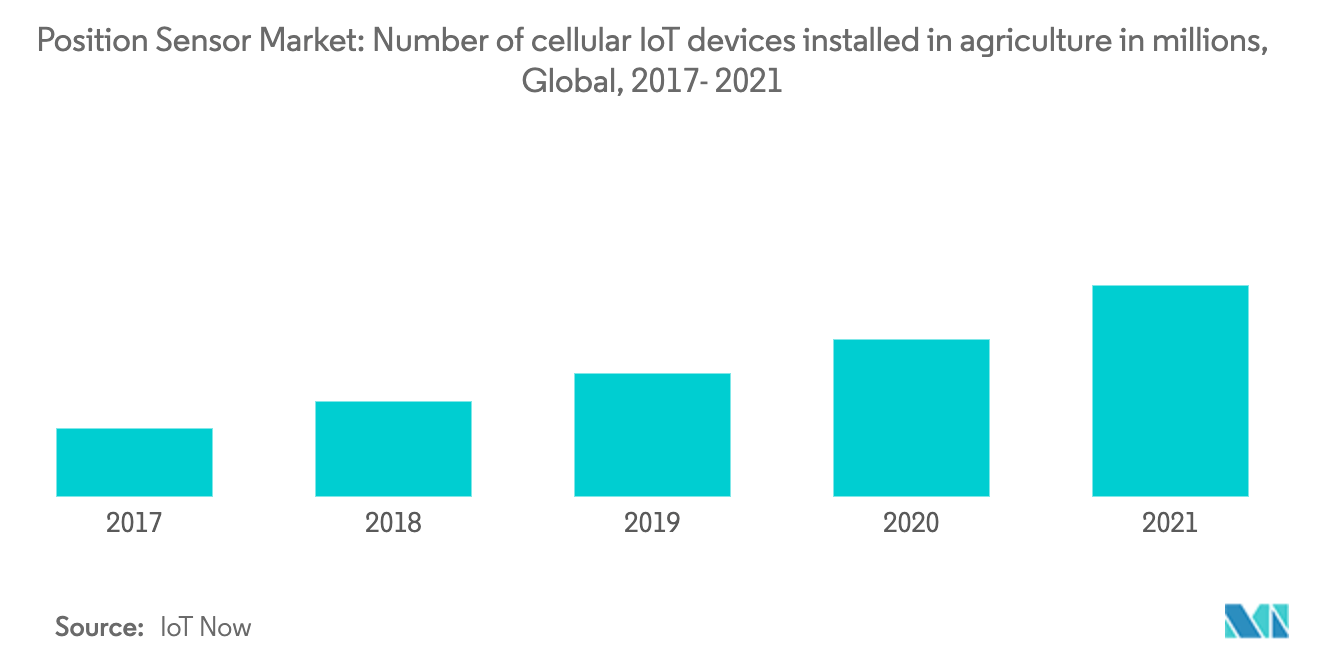Market Trends of Position Sensor Industry
This section covers the major market trends shaping the Position Sensor Market according to our research experts:
Smart Farming Practices, Precision Agriculture, and Government Support Driving the Market
Agriculture 4.0, a term coined in the World Government Summit in the form of smart agricultural practices and precision farming, is increasingly driving the position sensor market globally. The total number of Internet-of-Things (IoT)-based cellular devices installed in agriculture rose to 1.4 million in 2018 globally. Position sensor also gains awareness, and sensors are used for generating real-time information after the analysis of the data and causes the corresponding changes in the application rate. Conventional models of the utilization of a map-based approach are considered to be more productive. They allow room for problem analysis and subsequently adjust the variable rate application in the following steps. The various type of sensors being integrated for soil monitoring purposes includes electromagnetic, optical, mechanical, acoustic, and electrochemical, as far as industrial research has reached. In August 2019, a technology called Soilsens, which is a low-cost smart soil monitoring system, has come as a potential help to farmers facing farming decision predicaments. Proximal Soilsens Technologies Pvt Ltd developed the Soilsens product line, a startup incubated at the Indian Institute of Technology Bombay (IITB), Mumbai, with support from the Ministry of Department of Science and Technology (DST) and Ministry of Electronics and Information Technology (Meity). The system is embedded with a soil moisture sensor, soil temperature sensor, ambient humidity sensor, and ambient temperature sensor. Based on these parameters, farmers are advised about optimum irrigation through a mobile app. This data is also available on the cloud. There is also a portable soil moisture system. A survey by Agriculture and Agri-Food Canada in 2017 found that 75% of the sampled respondents intend to practice precision farming in the future. Along with unmanned air vehicles (UAVs) or drones outfitted with precision positioning sensors for plant-health monitoring, tractors and combine harvesters are progressively using position sensor technology to increase harvest yields and long-term farm profits. For instance, John Deere launched its new combine harvester at the 2019 Consumer Electronics Show, which uses GPS, Artificial Intelligence, and sensor solutions to decide on how, where, and when to cut the farmer's field. As such, precision agriculture is expected to play a significant role in driving the position sensor market during the forecast period.

North America - The Largest Market for Position Sensors
North America has been at the forefront of the deployment of position sensors in the field of agriculture. The region contributed to the largest share of the overall position sensor market. The United States was the largest market in the North American region. According to a report by the Economic Research Services, USDA, large-holding farms are more likely to adopt precision agriculture technologies, including position sensors. The average farm size has been increasing at the rate of two acres per farm since 2012, with the total number of farms declining by 12,000 to 2.05 million in 2017. In the United States, larger farms are increasing their use of precision agriculture to cover the increased farm size and overcome technological barriers to implementing practices. Among the small farms in the United States, which make up greater than 85% of United States farm totals, only a few have adopted precision agriculture. According to USDA, the adoption of precision technology in corn cultivation can add marginal gains of USD 3.73 to the net returns of USD 85.0 fetched by the US corn farmers. A study by Goldman Sachs revealed that the overall sensor prices fell by 50% in the last decade, thereby leaving a wide opportunity for precision agriculture to grow. Thus, automation is expected to give a boost to the adoption of precision agriculture in the country, thus, driving the position sensor market.


